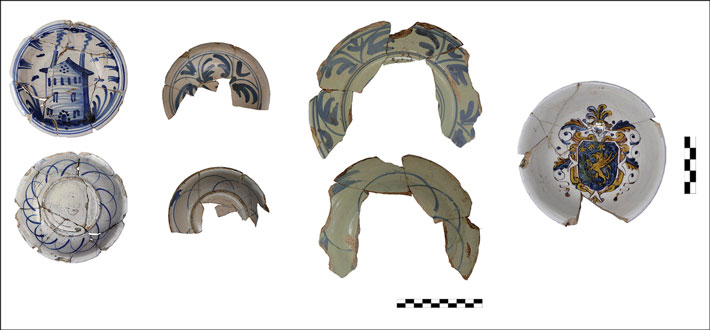 ROME, ITALY—Live Science reports that a dump site found in a cistern in Rome’s ancient Forum of Caesar has yielded a collection of 500-year-old artifacts, including medicine bottles, rosary beads, glass jars, coins, and a ceramic camel figurine. The items have been identified as waste from the Ospedale dei Fornari, or Baker’s Hospital, which was sponsored by a sixteenth-century baker’s guild. Each person admitted to the hospital would have been supplied with a jug, a drinking glass, a bowl and a plate. Many of the glass vessels recovered from the dump, however, are thought to have been used for collecting urine for medical analysis. Such vessels were called matula in medieval Latin medical texts, explained Rubina Raja of Aarhus University, Jan Kindberg Jacobsen of the Danish Institute in Rome and Aarhus University, and Claudio Parisi Presicce of Italy’s Capitoline Superintendency for Cultural Heritage. Carbonized wood and lead furniture clamps found in the cistern may be the remains of objects taken from the homes of plague victims and burned as a hygienic measure, as recommended in 1588 by Italian physician Quinto Tiberio Angelerio, the researchers added. The cistern was eventually capped with a layer of clay, perhaps in an effort to seal off infectious waste, concluded team leader Cristina Boschetti of Aarhus University. To read about the Arch of Constantine in the heart of ancient Rome, go to "A Monumental Imperial Biography."
ROME, ITALY—Live Science reports that a dump site found in a cistern in Rome’s ancient Forum of Caesar has yielded a collection of 500-year-old artifacts, including medicine bottles, rosary beads, glass jars, coins, and a ceramic camel figurine. The items have been identified as waste from the Ospedale dei Fornari, or Baker’s Hospital, which was sponsored by a sixteenth-century baker’s guild. Each person admitted to the hospital would have been supplied with a jug, a drinking glass, a bowl and a plate. Many of the glass vessels recovered from the dump, however, are thought to have been used for collecting urine for medical analysis. Such vessels were called matula in medieval Latin medical texts, explained Rubina Raja of Aarhus University, Jan Kindberg Jacobsen of the Danish Institute in Rome and Aarhus University, and Claudio Parisi Presicce of Italy’s Capitoline Superintendency for Cultural Heritage. Carbonized wood and lead furniture clamps found in the cistern may be the remains of objects taken from the homes of plague victims and burned as a hygienic measure, as recommended in 1588 by Italian physician Quinto Tiberio Angelerio, the researchers added. The cistern was eventually capped with a layer of clay, perhaps in an effort to seal off infectious waste, concluded team leader Cristina Boschetti of Aarhus University. To read about the Arch of Constantine in the heart of ancient Rome, go to "A Monumental Imperial Biography."
Rome’s Renaissance-Era Medical Waste Studied
